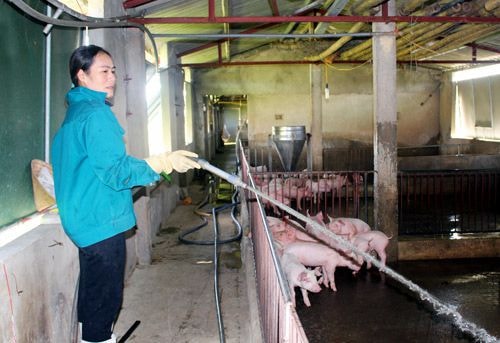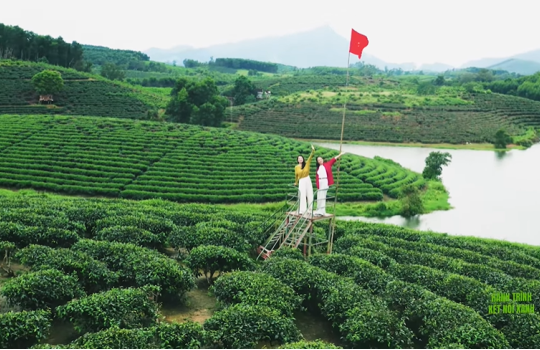Proactively prevent and control diseases in livestock farming
(Baonghean) - The changing of seasons is the time when diseases in livestock have the conditions to develop and cause strong damage, especially in the current small-scale, fragmented livestock farming conditions, where vaccination work has not met the requirements. In this situation, what have the authorities and people done? We have investigated this issue.
As one of the localities with the highest vaccination rate on livestock in the province, in the 2015 spring vaccination season, Thanh Chuong district achieved a vaccination rate of 74% against septicemia in buffalo and cows, 78% against foot and mouth disease (FMD), 54% against septicemia in pigs and 54% against swine fever... Ms. Phan Thi Huyen, an official of the district's Agriculture Department, shared: The district has a large herd of nearly 74 thousand buffaloes and cows, over 113 thousand pigs and 1.43 million poultry. To achieve such results, it is thanks to the close direction from the district to the communes, and the veterinary staff closely following the grassroots to propagate and mobilize. However, although good results were achieved in vaccination, they were mainly in concentrated livestock farms. Ms. Tran Thi Tu in Trung village, Thanh Linh commune said: "My family has 2 cows and a few dozen chickens, but up to now I have only vaccinated the cows. I have raised few chickens and let them roam in the garden for meat, so I have hardly ever vaccinated them. In the village, not only my family but almost all small-scale households are only interested in vaccinating their livestock."
 |
| Concentrated pig farm of Mr. Le Quoc Tan's family in Hung Tien commune (Hung Nguyen). |
According to the representative of the provincial Veterinary Department, the work of disease prevention and control still faces many difficulties. Nghe An is a province with a large livestock herd, with 765 thousand buffaloes and cows, including 45 thousand dairy cows; over 1 million pigs and nearly 17 million poultry. In recent years, concentrated farming has tended to develop but not much and small-scale household farming still accounts for the majority. Transportation, trading and small-scale slaughtering are still common, causing difficulties in management and posing a risk of disease outbreaks. Currently, there are only 33 centralized slaughterhouses in operation in the province. According to preliminary statistics, only about 0.34% of livestock are slaughtered at these centralized slaughterhouses. While people's awareness is still limited, both in raising, vaccinating and consuming, most commune-level authorities have not really taken part or are still respectful. According to Ms. Ba Thi Dung, an officer of the Hung Nguyen Department of Agriculture, in recent years there have been few epidemics in the area, so the mentality of the people and local officials is somewhat subjective and negligent, which is also a common situation in many other localities in the province.
The current rainy and humid season is the time when diseases have favorable conditions to break out and cause harm to livestock, especially avian influenza, FMD and septicemia. Since the beginning of the year, avian influenza has occurred in 3 locations: Dien Tan (Dien Chau), Quy Hop and Quynh Tan (Quynh Luu), destroying thousands of poultry. According to Mr. Dang Van Minh, Deputy Head of the Provincial Veterinary Department, avian influenza is a "massive epidemic", causing very heavy damage. Thanks to good work in preventing and suppressing the epidemic, in recent years it has turned into a "local epidemic", with a small, scattered scale. However, we cannot be subjective with this epidemic because the avian influenza virus is currently changing a lot and is extremely complicated, with new strains appearing such as H5N6, H7N9, which have a very high ability to infect humans and kill livestock very quickly, and there is no specific medicine to treat it.
Although the State has regulations on penalties in animal husbandry and veterinary medicine, the effectiveness of penalties is not high because the government is not resolute, still respectful, implementing in a "formal" manner, and has not given specific targets for urging and directing. While reality proves that in localities where the commune-level government really gets involved and resolutely handles such as Thanh Linh (Thanh Chuong), Nam Nghia (Nam Dan), Linh Son (Anh Son)... the vaccination rate for livestock is very high. Besides, the propaganda work to the people has not really met the requirements, people have not been fully informed of the State's regulations in the field of animal husbandry and veterinary medicine. In addition to the 8 districts that are not provided with FMD vaccine due to being included in the national control program, Program 30a is Ky Son, Con Cuong, Tuong Duong, Anh Son, Thanh Chuong, Quy Hop, Quy Chau, Que Phong and the communes in the dairy cow belt in Nghia Dan, Quy Hop have a fairly high vaccination rate for this disease; the remaining localities have a very low rate, while in the plain districts, the risk of disease spreading from trading markets and from slaughtering and transportation is very high. In the spring vaccination of 2015, the vaccination rate for septicemia in buffalo and cows was only 57.2% of the total herd, LMLM in buffalo and cows was 48.2%. In the pig herd, the vaccination rate for septicemia was 22.4% of the total herd, and cholera was more than 25%.
This year, the rainy season has come early, according to forecasts of heavy, prolonged rainfall with complex developments, which will cause flooding in many places, especially in districts along the Lam River such as Anh Son, Do Luong, Nam Dan, Hung Nguyen and some low-lying plain districts such as Yen Thanh, Quynh Luu, Dien Chau... To proactively prevent adverse situations that may occur for livestock, localities need to continue to organize vaccination of livestock and poultry in the autumn season. Strengthen monitoring, quickly detect cases of livestock diseases to handle small-scale outbreaks. Strictly implement the information and reporting regime on periodic and sudden epidemics when epidemics occur. At the same time, strengthen propaganda on prevention and control of livestock and poultry diseases so that people can proactively implement. Instruct livestock farmers to take measures to care for, raise, and closely monitor diseases during the rainy and stormy season such as proactively covering, repairing and upgrading livestock barns to prevent flooding; Have a plan to stockpile food for livestock during the rainy season such as straw, hay, potatoes, cassava, bran, concentrated feed...; plant more grass and corn to proactively provide food for buffaloes and cows.
Communes outside the dike, or areas frequently flooded and landslide-prone, must proactively arrange locations to relocate and gather livestock and poultry during floods and flooded barns. Communes in mountainous areas instruct people not to let buffaloes and cows roam freely in forests or along streams, to prevent them from being swept away by floods. Regularly monitor the health of livestock in the family. If there are unusual signs of illness, immediately report to the commune veterinarian and local authorities for timely handling; do not slaughter or sell sick livestock and poultry to spread the disease. After floods, the environment is polluted, pathogens spread widely, it is necessary to implement environmental sanitation and disinfection to destroy pathogens, in the spirit of sanitation and disinfection as the water recedes.
Phu Huong

.jpg)


.jpg)


.jpg)

